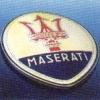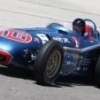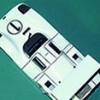I'd add this point to support the contention (which I hold) that Can-Am II was at the time and remains very underrated and underappreciated.
I became a motorsports fan right around 1973, i.e. about the time the Penske Porsche 917-30/SCCA rules makers (take your pick) were killing the original Can-Am. Unable to get to the races on my own as a pre-adolescent, I never was able to see the series as it happened. Thus, I had only words and photos to inform me of how great these cars were, no personal experiences.
Fast-forwarding to 1977, when as a teenager I had more access to racing magazines and could get to an occasional race if desired, here comes this "new" professional series featuring big, brawny, high-powered sports cars the likes of which hadn't raced in the U.S. since I became a fan.
Plus, you had established stars and stars in the making from North America and overseas (Tambay, Villeneuve, Alan Jones, Ickx, Keke, Rahal, Danny Sullivan, Little Al, Geoff Brabham) duking it out with highly regarded, home-grown road racing veterans like Follmer, Al Holbert, EFR and John Morton. Not to mention guest shots by drivers like Big Al, Depallier, etc.
And while the first year was dominated by the straightforward Lola 332 conversion, the diversity of car designs really started taking hold soon after, whether 332s with non-Haas bodywork (the Schkee, the Bud Spyders, Follmer's and Rahal's Prophet, the Frissbee and its VDS development) or completely fresh ideas like Holbert's CAC chassis or Tony Cicale's 2-liter Ralt-based ground effects entry. (In fact, didn't Can-Am II have the first full-on ground effects sports racers anywhere, starting with the Holbert/Carl Hogan/Lee Dykstra car of 1979? Don't recall any of the European sports prototypes going that route at the time.)
And while some of them were behemoths relative to other sports racers, they were plenty fast.
Yeah, I knew where they came from, but they were the baddest things to be found on road courses in North America at the time, and that's the point for a fan of my time. USAC champ cars were still almost all oval; IMSA had the cool GT cars but they were still GTs, not prototype-ish racing cars, with the GTP rules still several years in the future; there was no access to the Porsche/Renault/Alfa prototypes of the FIA championships (not anywhere around me, anyway).
For loud, fast, big sports racers with top-shelf talent and a variety of interesting engineering solutions, it was all I (and North America) had for five or six years. And in those five or six years, it was pretty damned good.
Edited by racinggeek, 07 February 2020 - 21:42.
![]()


























